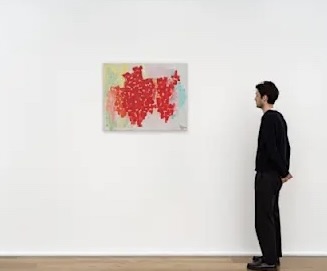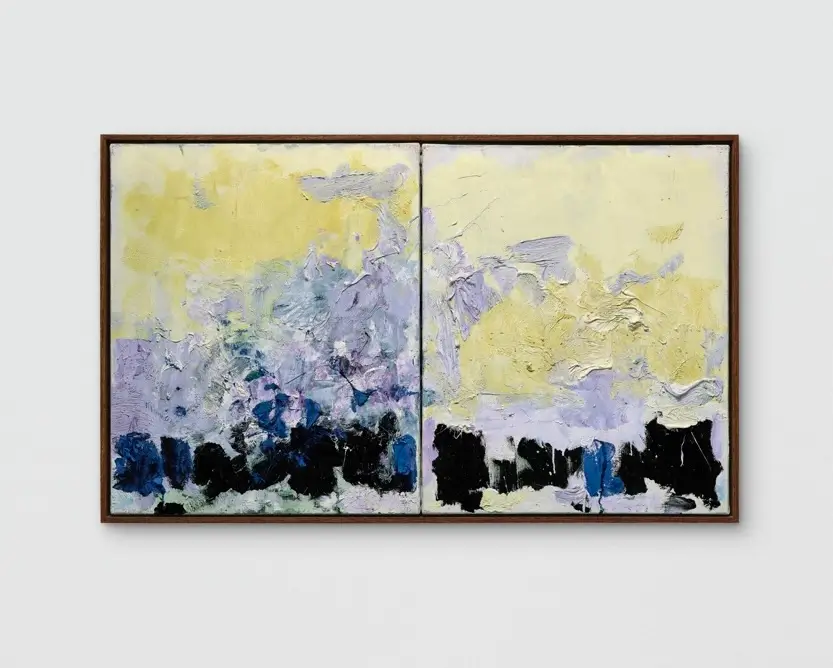Alma Thomas’s Bed of Red Azaleas (1968) is at once a garden painting and a meditation on national form. To the naked eye, the canvas unfolds as a field of rhythmic crimson strokes, evoking azalea blossoms in full bloom. Yet some viewers, squinting or standing at a distance, notice another shape: perhaps a semblance of the United States itself, rendered in vibrating reds against intervals of green and brown.
Alma Thomas: Blossoming Late into History
Born in 1891 in Columbus, Georgia, Alma Woodsey Thomas moved with her family to Washington, D.C. as part of the Great Migration. She became the first graduate of Howard University’s fine arts program and later studied at American University. For more than three decades she taught art at Shaw Junior High School, nurturing creativity in her students while setting aside her own ambitions.
It was only after retiring in 1960, at the age of sixty-nine, that Thomas devoted herself fully to painting. What followed was a decade and a half of extraordinary output: abstract works marked by brilliant color, short mosaic-like strokes, and inspiration drawn from her own garden. Her late career coincided with the height of the civil rights movement and a shifting art world that was just beginning to reckon with the absence of African American women from its mainstream narratives.
By the time she painted Bed of Red Azaleas, Thomas was nearly eighty years old. Far from winding down, she was creating some of the most daringly vibrant canvases of her life — works that secured her a solo exhibition at the Whitney Museum in 1972, making her the first Black woman to achieve that milestone.
View this post on Instagram
A Formal Reading: The Mosaic of Brushstrokes
The painting is built from Thomas’s signature “dabs” — short, block-like strokes applied in rows and clusters. These strokes resemble tesserae in a mosaic or pixels in a digital field, each one distinct yet subsumed into a greater whole.
In Bed of Red Azaleas, the strokes form dense clusters of crimson, broken by intervals of green and earthen tones. This creates a visual rhythm, like syncopated notes in a jazz score. The viewer’s eye dances across the canvas, guided not by linear perspective but by pulsations of color.
Standing back, the overall composition appears to coalesce into a larger shape. For some, it is a blooming flowerbed. For others, it is the loose outline of the United States — an accidental but suggestive echo.
The United States in Bloom: Coincidence or Intention?
Was Thomas intentionally painting a map of America in floral disguise? There is no evidence in her statements or archives to suggest so. She spoke of color, light, music, and gardens — rarely of national symbols.
Yet art is not only what the artist intends but also what viewers perceive. And in Bed of Red Azaleas, the resemblance is strong enough to spark a dialogue. If the work does evoke the United States, it is a nation rendered not in flags and borders but in flowers — blooming, fragile, radiant.
For a Black woman born in the segregated South and working in the segregated capital, to envision the nation as a bed of flowers may have been an unconscious act of reclamation: America as it might be, not as it was.
Market Escalation: Alma Thomas in the Contemporary Art World
In recent years, Alma Thomas’s market has surged dramatically. Once overlooked, her paintings now command multi-million-dollar figures at auction:
-
A Fantastic Sunset (1970) sold for nearly $4 million at Christie’s in 2023, more than double its high estimate.
-
Snow Reflections (1966) fetched over $3.3 million at Sotheby’s the same year.
-
Earlier, works like Azaleas (1969) crossed the $700,000 mark, signaling a steady escalation in value.
-
Institutional validation: Major retrospectives, such as Alma W. Thomas: Everything Is Beautiful, have repositioned her as a central figure in American modernism.
-
Scarcity: Because she began her mature style late in life, there are relatively few large-scale canvases, making each one highly sought after.
-
Cultural momentum: The art world has sought to redress the exclusion of African American women, and Thomas’s joyous abstraction offers both critical and market appeal.
In this context, Bed of Red Azaleas would be a coveted canvas — one that combines her signature floral subject with a historically resonant date.
Dispair
Thomas often insisted that her art was about joy, not politics. Yet to insist on joy as a Black woman artist in 1968 was political in itself. It was an act of resistance to despair, a refusal to let hatred define one’s vision.
In Bed of Red Azaleas, the politics of beauty are clear. By painting azaleas as a metaphor for resilience, Thomas offered an alternative to the violence of her time. She showed that abstraction could be a site of healing, not just subtle protest.
Flow
Half a century later, Alma Thomas is finally recognized as a pioneering figure in abstraction. Her influence stretches across generations of artists who see in her work a model of how to merge personal vision, cultural identity, and universal beauty.
Bed of Red Azaleas embodies this legacy. It is at once deeply personal — rooted in her D.C. garden — and potentially national, echoing the outline of the country. It is abstract yet recognizable, liberal yet open to conservative appropriation. Above all, it is beautiful, reminding us that beauty itself can be radical.
When Alma Thomas painted Bed of Red Azaleas, she likely intended nothing more than to capture the splendor of her garden in bloom. Yet the canvas has come to bear more meanings: a map of the United States, a meditation on red in politics, a commodity in the art market, a symbol of liberal resilience.
No comments yet.








